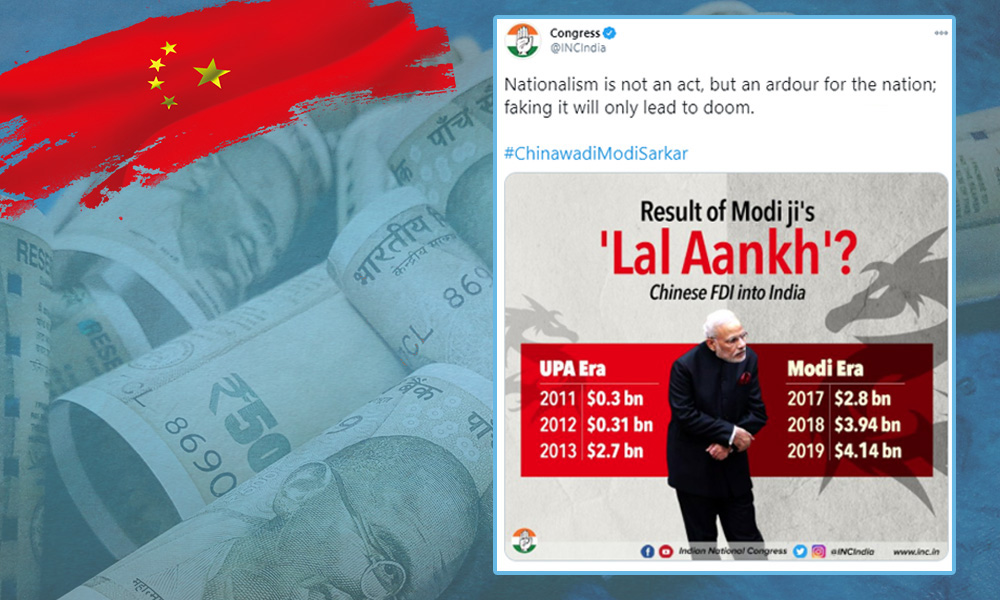
Fact Check: PIB Fact Check Says Congress Wrongly Claimed 'Chinese FDI Drastically Rose During Modi Regime'
India, 18 Jan 2021 5:16 AM GMT
Editor : Bharat Nayak |
As the founding editor, Bharat had been heading the newsroom during the formation years of the organization and worked towards editorial policies, conceptualizing and designing campaign strategies and collaborations. He believes that through the use of digital media, one could engage the millennial's in rational conversations about pertinent social issues, provoking them to think and bring a behavioral change accordingly.
Creatives : Abhishek M
" An engineer by profession, Abhishek is the creative producer of the team, graphic designing is his passion and travelling his get away. In more ways than one, he makes the content visually appealing."
PIB Fact Check refuted the claim of Congress that FDI from China has drastically increased during PM Narendra Modi's rule. The Logical Indian Fact Check team investigates the claim.
On January 7, 2020, PIB Fact-Check team, a unit of Press Information Bureau of India, did a fact check on a claim made by Indian National Congress (INC) on social media on the inflow of Foreign Direct Investment (FDI) from China. Congress had claimed that FDI from China has drastically increased during Prime Minister Narendra Modi's rule from $2.8 bn in 2017 to $4.14 bn in 2019. PIB refuted the claim saying that it actually decreased from $0.350 bn in 2017 to $0.163 bn in 2019.
A claim is being made on social media that the Chinese FDI into India has increased from $2.8 bn in 2017 to $4.14 bn in 2019.#PIBFactCheck: This data is #Fake and #Incorrect. The FDI inflow from China has declined from $0.350 bn in 2017 to $0.163 bn in 2019. pic.twitter.com/I3WrjxBxmH
— PIB Fact Check (@PIBFactCheck) January 7, 2021
The infographic posted by Congress showed that in 2017, FDI investment by China was $ 2.8 billion, in 2018 it was $ 3.94 billion and in 2019 it was $ 4.14 billion. They compared these figures with the FDI from China during the UPA regime. According to the infographics, in 2011, the Chinese FDI investment was $ 0.3 billion, in 2012, the investment was $ 0.31 billion and in 2013, the FDI investment became $ 2.7 billion. The infographic was shared with the caption, "Nationalism is not an act, but an ardour for the nation; faking it will only lead to doom. #ChinawadiModiSarkar." Archive of the Congress tweet can be seen here.
Congress shared the tweet in context with the ongoing tension between India and China. The Indian government had earlier banned Chinese apps citing national security. Hence, Congress shared the post to insinuate the hypocrisy of the Modi-led NDA government.
Claim:
The Chinese FDI inflow in India has drastically increased during Prime Minister Narendra Modi's rule (between 2017 and 2019).
Fact Check:
The Logical Indian did a keyword search and found a Business Today's report published on September 14, 2020. According to the report, the Chinese investment in India declined on an annual basis from $350.22 million ($ 0.35 billion) in 2017-18 to $229 million ($ 0.25 billion) in 2018-19 and further to 163.77 million (0.16 billion) in 2019-20. The Chinese FDI in Financial Year 2020 was $163.77 million. The article was attributed to a written reply by Minister of State for Finance Anurag Singh Thakur on the first day of the monsoon session.
We found the document related to the same on the Lok Sabha website.
The Logical Indian contacted the social media team of Congress, who shared with us the source of their data. They sourced their data to a report by Bloomberg Quint, published on June 19, 2020. The report spoke about the economic relationship between India and China. The report said that Chinese FDI into India in 2019 was at $4.14 bn, in 2018 was $3.84 bn and in 2017 it was $ 2.8 bn and it also reported that the Chinese Investment in India in 2011 was $ 0.3 bn, in 2012 was $0.31 bn and in 2013 it was $ 2.7 bn, which matches with what Congress had tweeted.
Menaka Doshi, The managing editor of The Bloomberg Quint, through email exchanges told us that their story was sourced from the China investment data from the American Enterprise Institute(AEI)'s China tracker. America Enterprise Institute (AEI) is a non-profit organisation that does research on government, politics, economics, and social welfare.
Invest India, a national investment promotion and facilitation agency, that focuses on sector-specific investor targeting and development of new partnerships to enable sustainable investments in India, had also reported that at least 23 deals were signed between Indian tech start-ups involving Chinese investors in 2020, which saw an influx of over $ 5 bn from China into India.
Gateway House, a foreign policy think-tank of India claimed that Chinese tech investors have put an estimated $4 billion into Indian start-ups. One of the major investment was $1.1 billion, for the acquisition of Gland Pharma by Fosun in 2018.
Why there is a difference between Congress data and PIB Fact-Check?
PIB Fact-Check's data on China's investment in India is sourced from Anurag Thakur's written reply in Lok Sabha while Congress's data is based on BloombergQuint report, which is sourced from American Enterprise Institute(AEI)' report. To understand the reason behind the discrepancy, we contacted AEI through email.
They informed us that they don't use the same method as used by any government for calculating FDI influx. AEI said, "We don't count transactions worth less than $95 million, for the sake of tractability. We include equity stakes of less than 10% because policy-makers care about amounts, not 9% versus 11%." They further added, "They use the home country of the investor, where most governments use the immediate source of the investment. For example, if a Chinese subsidiary in Singapore invests in India, we count that as Chinese investment where most governments count it as Singaporean."
What is FDI?
A foreign direct investment (FDI) is an investment made by a firm or an individual in one country into business interests located in another country. Generally, FDI takes place when an investor establishes foreign business operations or acquires foreign business assets in a foreign company.
While there was no evident conclusion, we observed both Congress and PIB Fact Check had taken data from two different sources. While one attributed to the data given in a document presented by Anurag Thakur in Lok Sabha, the other refers to the data collected by a foreign non-profitable organisation, AEI.
If you have any news that you believe needs to be fact-checked, please email us at factcheck@thelogicalindian.com or WhatsApp at 6364000343.
Also Read: Fact Check: Old Images Viral As Farmers Vandalising Hindi Signboards During Ongoing Protest In Delhi
 All section
All section














